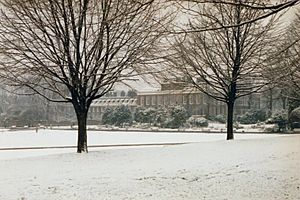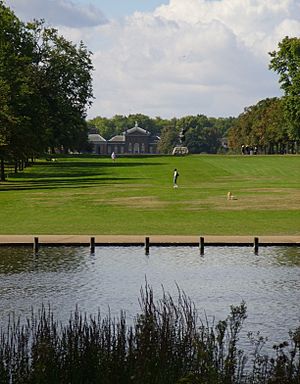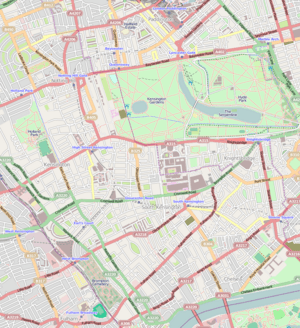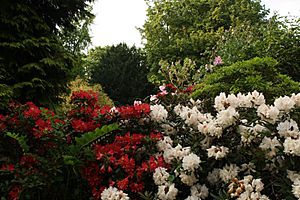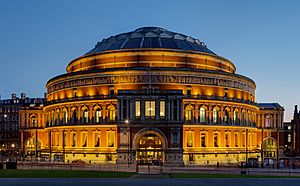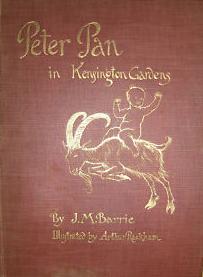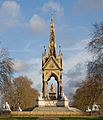Kensington Gardens facts for kids
Kensington Gardens are beautiful public gardens in London, England. They used to be the private gardens of Kensington Palace. These gardens are part of the Royal Parks of London, which are special parks owned by the King or Queen.
The gardens are located in western central London, right next to Hyde Park. They cover a large area of about 275 acres (1.1 square kilometers). Most of the gardens are in the City of Westminster, but a small part is in the Royal Borough of Kensington and Chelsea.
Kensington Gardens, along with Hyde Park, Green Park, and St. James's Park, create a huge green space in the middle of London. This helps London breathe! Kensington Gardens is also listed as a Grade I historic park, meaning it's very important for its history and design.
Contents
Where are Kensington Gardens?
Kensington Gardens are often seen as the western part of Hyde Park. A road called West Carriage Drive (also known as The Ring) and the Serpentine Bridge separate the two parks.
The gardens are fenced off and feel a bit more formal than Hyde Park. You can only visit Kensington Gardens during daylight hours. Hyde Park, however, is open from 5 AM until midnight all year.
Kensington Gardens has always been considered a "smart" place because it's more private, especially around Kensington Palace. In the late 1800s, Hyde Park became more popular because it was closer to busy areas like Park Lane and Knightsbridge.
History of the Gardens
Kensington Gardens was originally the western part of Hyde Park. King Henry VIII created Hyde Park in 1536 as a hunting ground.
In 1728, Queen Caroline asked for this part of Hyde Park to be separated. She wanted it to become a special landscape garden. Garden designers Henry Wise and Charles Bridgeman helped create it. They added popular features like the Round Pond, straight paths, and a sunken Dutch garden.
Between 1726 and 1731, Bridgeman also created the Serpentine lake. He did this by building a dam on the River Westbourne, which flowed through Hyde Park. The part of the Serpentine that is in Kensington Gardens is called "The Long Water."
At the north-western end of The Long Water, there's an area called "The Italian Garden." Here, you can find four fountains and several old-style sculptures.
Famous Buildings and Art
The area around Kensington Gardens was mostly countryside for a long time. It didn't develop much until the Great Exhibition in 1851.
Many of the original garden features and Kensington Palace are still there today. Other important public buildings and artworks have been added over time. These include the Albert Memorial, which is at the south-east corner of the gardens, across from the Royal Albert Hall. You can also find the Serpentine Gallery and a monument to John Hanning Speke.
The park is also home to the Elfin Oak. This is a very old tree stump, about 900 years old, that has been beautifully carved with tiny figures.
Kensington Gardens in Stories
Kensington Gardens is the setting for J.M. Barrie's famous book Peter Pan in Kensington Gardens. This story tells about Peter Pan's adventures before he went to Neverland. The fairies of the gardens were first written about in a poem by Thomas Tickell in 1722.
Both the book and the character of Peter Pan are honored in the park. You can see the Peter Pan statue by George Frampton there.
A novel called Kensington Gardens by Rodrigo Fresán also talks about J.M. Barrie, Peter Pan, and their connection to the park.
The old computer game Trinity by Infocom also starts in Kensington Gardens. Players can walk around different parts of the gardens, which are described in detail in the game.
Images for kids
-
The Diana, Princess of Wales Memorial Playground is inspired by Peter Pan.
-
Another view of the Physical Energy sculpture
-
The Albert Memorial
See also
 In Spanish: Jardines de Kensington para niños
In Spanish: Jardines de Kensington para niños


